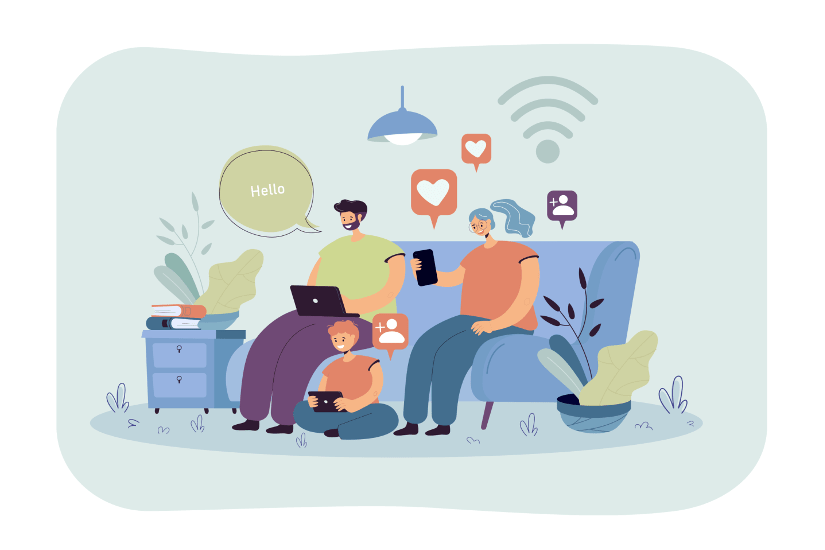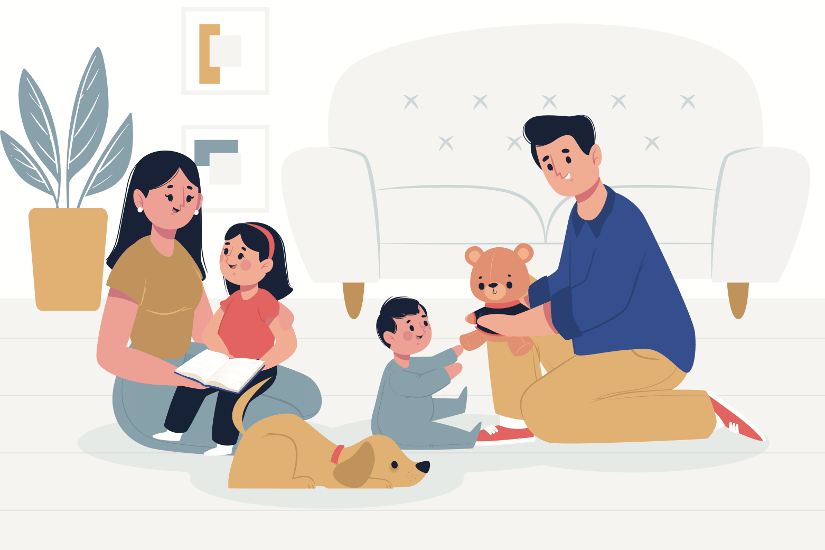
People vector created by pch.vector - www.freepik.com
Cartoons. Rhymes. Stories. Games. These are the names of your child’s new best friends in current times. Blame it on the COVID situation, perhaps. Schools have been locked down for almost a year now. Some parents are working from home; for the rest, work has doubled than ever.
Kids are bored, inevitably. They happily find comfort in the company of their digital companions that never fail to entertain them - 24/7.
Are the parents happy? Absolutely not. They may have been the ones to introduce these companions to their children at first (compelled by the need of the hour). Not to forget, distant learning through digital mediums has only strengthened this “friendship” bond.
But parents aren’t happy at all with the ‘increased’ exposure of their little ones to the screen. And for the slightly grown-up kids, this displeasure transforms into a sense of “fear” at the idea of digital and social media “threatening” the innocence of their kids at a rather impressionable age.
Is there any way out of the scenario? Perhaps not. Our kids have been born in the new digital age where even a one-year-old learns to swipe up a mobile screen faster than he learns to talk! How much can we control? How much is enough?
This does not mean in any way that we as parents have lost our control or say in the matter. We too are part of the digital age and therefore it’s only wise to learn the rules of digital age parenting.
Keeping Pace With the Times - 5 Rules Every Parent Should Set and Know
1. Plan a digital media schedule for the whole family
As a parent, when you feel the need to set any ground rules for the benefit of your whole family, always create a plan. And you can surely make this in discussion with the other members as well.
Set specific times (which you find reasonable) for using digital media at your home. Remember, this is going to be a family plan (you included) so it’s very important that you abide by those rules too. Kids mimic elders so if you use those mediums reasonably, your kids would too.
Take for instance that your child needs to attend online classes for, say, 4 hours every morning. Keep at least 2 hours after lunch as their “media unplug” time (you can label it in a fun way to make it sound inviting to your child).
Encourage them to play outdoors in that time or do anything else which helps them unwind. Avoid watching TV yourself or browsing through social media on your phone during this time to avoid questions like “If you can do it, why can’t I?”
Towards evening, you may again allow them to either watch TV/play online games or if you have a teen (chat up with friends online/watch something relevant and useful to them on YouTube perhaps) for maybe an hour.
Time it and make sure they know that they need to respect that time limit. Explain this schedule well in advance to your kids - have an open talk/discussion - answer their questions, tell them why this is important. It’d make it easier for them to follow this.
2. Go tech-free for some time in the day
You can include this as part of your digital media plan detailed above. Keep some time in the day for those small, simple pleasures that no media can ever substitute for! Family mealtimes, for instance.
Try having meals together as a family, at least once in a day. If dinner is the most preferable and convenient time for everyone to eat together, make a “no-mobile-use” rule at the dinner table for everyone (again, you including).
Keep some time in the day to play with small kids, keeping them away from screens, or have a heart-to-heart talk with your teens for some time in the day. Go for long drives. Avoid fiddling with the phone that time; enjoy listening to music together. Spend more time in outdoor spaces as a family - play games.

Technology vector created by pch.vector - www.freepik.com
3. Keep a watch on the apps
Kids are smart these days, for they’re well-acquainted with the smart technology. These tech kids can download apps themselves on touch phones and laptops in a fraction of a second. Most of it is propelled by the demands of the current e-learning scenario. And the remaining apps (not necessarily educational)look too good for kids to resist.
Your role here is to keep an eye out for what apps your child is downloading on the digital medium they use. Also, make sure that your child knows that they’re ideally supposed to ask/let you know in advance if they wish to download a particular app. Do your own homework at that time. Look up the app and its contents before nodding your approval.
4. Talk more; answer your child’s whys and hows
If you don’t, your kids would inevitably try to seek answers from digital media. With the media at their disposal being so user-friendly and easy-to-operate, it isn’t too difficult for them to go look something up online. Once you’ve handed them technology in their hands, it’s actually difficult to keep tab on it all the time.
With small kids, you may lock all the other apps except the one they use; what about slightly older preteens or teens? And how about kids discussing things among each other? This is why talking to them helps. Sit with them and watch what they’re watching for some time. This too would give you an idea on what they’re being exposed to.
With teens, it might be a better idea to have a talk with them once in a while on what they have/are watching these days, about the discussions they have with their friends, etc. If you feel anything different, discuss it with them calmly, explaining the ill-effects of it, if any, and gently guide them through the right direction.
5. Avoid bribing the child with TV/phone as a pacifier
The moment your child gets bored, angry, upset, or bursts into tears for any reason, avoid handing them over the TV remote/mobile phone in an attempt to pacify their emotions. It’s natural for most of us to look up to technology as a handy pacifier for settling a disturbed child. However, it’s a better idea to actually help the child learn to deal with strong emotions through other ways in the long run.
Encourage the child to communicate what they actually want at the moment. Avoid jumping the gun and being too quick in switching on the TV/handing over the phone the moment the emotional outburst breaks. Talk, ask, allow them to experience what they are for some time. Offer a solution if you can.
Remember - these emotions will keep surfacing several times ahead in life. You might want to help them learn coping with them better than to depend on temporary means like digital media.
Related: Have You Tried Tough Love?

Love vector created by pikisuperstar - www.freepik.com
Final Thoughts
Digital media is the new reality of today. How much ever we wish that our kids would play more outdoors and be with nature, the way we grew up, it’s going to be difficult imagining so. These are today’s tech kids - smart, way smarter than we were at this age. A lot of it can be attributed to early-age media exposure. But it isn’t entirely bad, if you look at it.
Digital media can be used to great advantage for the kids - in helping to improve their verbal, analytic, and reasoning skills, for instance. The only thing we as parents need to be responsible for is to keep a watch, at all times. And, in a way that doesn’t seem invasive but at the same time prevents the child from being trapped in the clutches of digital or social media.
Along with keeping a watch, frequent and open communication with the child is going to help you both a lot. Create gentle awareness, help wherever needed. All said and done, kids will remain kids. They would look up to media as a handy pacifier and tool for entertainment. It’s okay to let them under some set ground rules.
(What are your family rules for effective digital-age parenting? Do share in the comments below. If you found the post helpful, please do share it around in your network to help other parents too. For more such useful posts, follow me on social media and don’t forget to subscribe to the blog to receive all new posts by email.)
